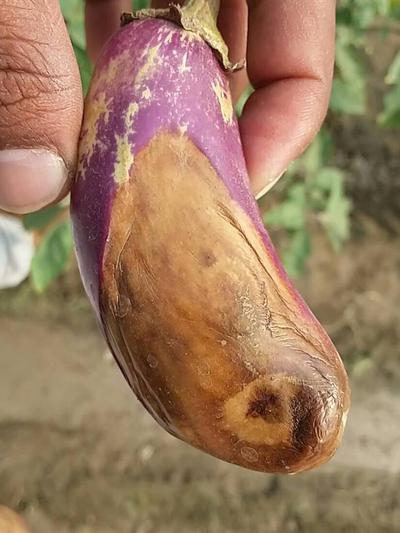Phomopsis Blight
Diaporthe vexans
Fungus
In a Nutshell
- Brown, soft, sunken lesions on fruits.
- Gray to brown spots, light centers on leaves.
- Blighting and withering of leaves.
- Dark, sunken cankers on stems.
Can also be found in
Symptoms
Symptoms appear in leaves, stem and fruit, being most visible in the latter. Small gray to brown spots with light centers appear on leaves and may eventually become numerous and cover large areas of the leaf blade. Severely-infected leaves turn yellow and later wither, with cracked, torn tissue (leaf blight). Stems may develop brown to dark, cracked and sunken cankers. At the base of the plant these cankers may encircle the stem and hinder the transport of water and nutrients, eventually killing the plant. Brown, soft, sunken lesions appear on fruits. As they enlarge, they often merge, covering a large portion of the fruit surface and creating concentric rings of small black dots on their margins. Eventually, fruits rot. Small black dots are also visible on older lesions in leaves and stems. If conditions become dry, infected fruit become shriveled, dry, and mummify on the plant.
Recommendations

Organic Control
Treatments with organic fungicides may be useful in reducing the incidence and severity of the disease. Products based on copper solutions (e.g. Bordeaux mixture) can be applied as foliar spray. Neem extracts are a safe and eco-friendly solution that has been used in the management of the disease. Treatment of seeds with hot water can also be considered (56 °C for 15mn).

Chemical Control
Always consider an integrated approach with preventive measures and biological treatments if available. If disease is identified in the field and economic thresholds are reached, treatments with fungicides are recommended. The more common fungicides applied as foliar sprays are azoxystrobin, boscalid, captan, chlorothalonil, copper oxychloride, dithiocarbamates, maneb, mancozeb, thiophanate-methyl, tolclofos-methyl, pyraclostrobin. Fungicides are most effective when combined with cultural control strategies. Seed treatments may also be utilized, for example with thiophenate methyl (0.2%).
What caused it?
The symptoms are caused by the fungus Phomopsis vexans, a pathogen that seems to be restricted to eggplants (despite some cases of infections of tomato and pepper being reported). The fungus survives in crop debris and its spores are spread by wind and rain onto healthy plants. It is also thought to be carried in and on seeds. This makes the acquisition of certified seeds and healthy seedlings important in the fight against this disease. Penetration of leaf tissues can take place within 6-12 hours, and hot and relatively humid conditions are required for infection and disease development (27-35° C). The development of fruit lesions is most likely to occur at 30°C and 50% relative humidity in storage chambers.
Preventive Measures
- Use high-quality certified seeds from reliable sources.
- Alternatively, collect seeds from healthy plants.
- Plant resistant varieties if available and suitable for your market needs.
- Keep a larger space between plants in and between rows.
- Plant parallel to the prevailing wind direction to allow leaves to dry faster.
- Plan irrigation so that leaves have time to dry before dusk.
- Use fertilizer with low nitrogen rate and higher rates of phosphorus and potassium.
- Remove and destroy crop residues after harvest (deep plowing or burning).
- Keep fruits at optimal storage temperatures (cool and dry).
- Practice crop rotations (3 years or more).



